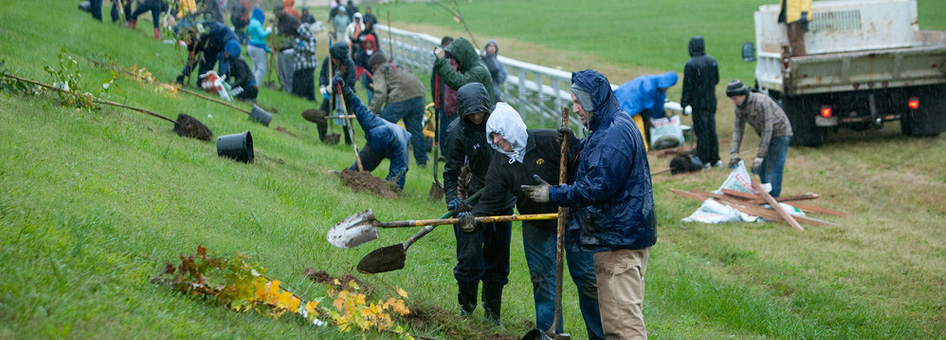Blue Water Baltimore

The Rauch Foundation was instrumental in creating Blue Water Baltimore in 2010 through the merger of five local watershed advocacy and conservation groups. The groups had all built their own identities through years of work, yet they agreed to relinquish their separate identities to achieve a broader regional impact.
Blue Water Baltimore’s mission is to restore the quality of Baltimore’s rivers, streams, and harbor to foster a healthy environment, a strong economy, and thriving communities. It works towards a future when neighborhood streams are safe for fishing and swimming and a clean harbor is the pride of Baltimore.
Careful planning and a well-orchestrated process
The five founding or “legacy” organizations were the Baltimore Harbor Watershed Association, Baltimore Harbor Waterkeeper, Gywnns Falls Watershed Association, Herring Run Watershed Association, and Jones Falls Watershed Association. The groups had informally considered joining forces for several years, but it was the 2008 economic crisis and resulting fundraising challenges that jump-started serious merger discussions.
As recounted in the report “Merger: The story of five Baltimore watershed organizations that became one,” “The merger moved them toward a future that had yet to be defined. The merger process itself also proved to be a new and unique experience. Mergers are far more common in the business world, usually between two entities. The Baltimore groups operated in the mission-driven, people-centered culture of the nonprofit workplace. They aimed to merge five organizations, not two. No known precedent existed for a nonprofit merger of this size. Experienced guidance was hard to find… Operationally, the five groups were quite different. Their finances, staff size, organizational age, board dynamics, and workplace arrangements varied widely. They also wondered how a merger could impact their established success. Would they lose members or volunteers? How would grant-makers react? Where would they find time to work on such questions, or money to pay for it?”
The Rauch Foundation and other funders facilitated initial discussions and explorations, funded collaborative activities to help the organizations build relationships with one another, sought expertise from others who had gone through mergers, and networked with other funders to build support for the merger. The Foundation also made strategic grants linked to deadlines and specific goals, and it supported organizational and staff development and training as part of the merger.
The resulting organization
As related in the subsequent report “Launched: The first 3 years of Blue Water Baltimore,” “When the merger was first announced, Blue Water Baltimore was in a unique position. It was a new nonprofit organization, but without the traditional start-up pains. It emerged on the scene with experienced staff, a structured board of directors, and a budget. Its leaders had existing relationships with area grant-makers, and the inherited membership base topped 270. Programs and projects were already underway as legacies of the merging organizations.”
Building on those strengths, Blue Water Baltimore now has greater capacities than its individual members had previously. As “Launched” continues, for instance, “Blue Water Baltimore’s budget is much larger than the combined budgets of the five founding organizations. The increase was due in part to the new organization’s regional scope, but it also reflects the continuous communication with grant-makers established during the merger.
Going forward with increased strength
The merger that brought about Blue Water Baltimore created an impressive new vehicle working on behalf of clean water in the Baltimore region and capably managing large restoration projects.
In 2017 alone, Blue Water Baltimore and other advocates spent many hours working toward a strong and transparent legal agreement between the City and the federal Environmental Protection Agency to ensure that sewer pipes are repaired and maintained over the next 13 years to significantly reduce the amount of pollution entering waterways. Blue Water Baltimore stopped a scrap-metal recycling facility from releasing toxic chemicals into the Patapsco River and discovered an oil spill in the Jones Falls. It brought a barren median on Route 40 back to life with hundreds of new trees and helped residents from Mondawmin and Oliver neighborhoods express themselves with photography to spur community conversations. It helped bring cherry trees back to Cherry Hill, removed tens of thousands of square feet of impervious surfaces, and engaged thousands of volunteers in Baltimore City and County to plant, clean, and advocate for cleaner water.
Blue Water Baltimore is only growing stronger, as needs and opportunities unfold. New EPA regulations require state and local governments to become more focused on water pollution in the Chesapeake Bay, so Blue Water Baltimore has an unprecedented opportunity ahead to galvanize support, effect change, and influence regional policy – an opportunity that would not have been realized as fully if five separate organizations had not merged into one.
